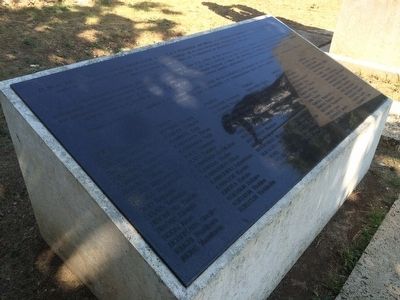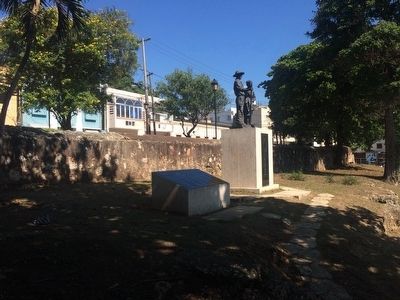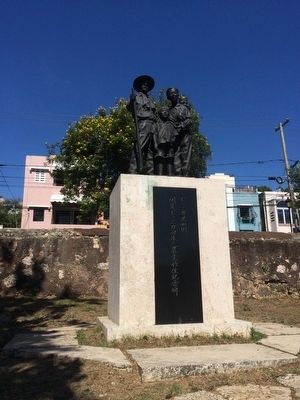Ciudad Colonial in Santo Domingo, Distrito Nacional, Dominican Republic — Caribbean Region of the Americas (Hispaniola, Greater Antilles, West Indies)
Japanese Immigration to the Dominican Republic
Inmigración Japonesa a la República Dominicana
Inscription.
El 26 de julio de 1956 se inició la inmigración agrícola y pesquera japonesa a la República Dominicana con la llegada de un grupo de inmigrantes japoneses al Puerto de Santo Domingo, en el barco Brasil Maru. Durante los años siguientes 1319 personas pertenecientes a 249 familias, se establecieron en diferentes zonas del país.
Los asentamientos resultaron extremadamente dificiles debido a la aridez de los terrenos, entre otros factores. Ante esta situación muchas inmigrantes agrícolas optaron por emigrar a paises de America del Sur o retornar a su país de origen. Los inmigrantes pesqueros, careciendo de los recursos adecuados para el desarrollo de esa actividad, regresaron a Japón. Sin embargo, las familias aquí nombrados, con el espíritu pionero firme y el orgullo y dignidad de ser japoneses, superaron grandes adversidades y permanecieron en la República Dominicana.
Desde entonces esas familias y sus descendientes gozando de la confianza y el respeto del pueblo dominicano, contribuyeron y seguirán contribuyendo con el desarrollo y la confraternidad entre ambos paises.
Familia • Arai Tatsuni • Ariyama Shinsaburo • Fujikawa Hiroshi • Fukinaga Tsunokichi • Hamada Matsuo • Hamaya Tejichi • Hidaka Masamitsu • Hikaka Tsuneyasu • Higo Katsumi • Hirata Tamotsu • Hiromitsu Yoshiki • Hirose Kimiaki • Hodai Iwao • Hoshikawa Suejiro • Iguchi Yoshiharu • Inoue Yasutomo
Familia • Inuyama Sheichi • Kameda Seikichi • Kamimae Toru • Kasahara Harue • Kasahara Soiji • Kato Tsunenori • Kato Yutaka • Kawabata Tshikatsu • Kawara Yoshio • Kawashiro Ritsu • Kawashiro Tetsuemon • Kawazoe Kazuo • Kimura Kurato • Kokubun Rokuro • Kokubun Yoshimi • Kokubun Yoshinobu
Familia • Kokubun Yoshinori • Kokubun Yoshito • Komatsu Kazuo • Komatsu Toyoshige • Kunimatsu Goro • Maruyama Kazumi • Masuoka Takeo • Matsumura Masami • Matsunaga Mamoru • Mikame Zenpei • Miyanowaki Hiroyoshi • Mukai Kiyoshi • Murata Susumu • Naito Rinzo • Nakagawa Toshio
Familia • Nakahira Kinoe • Nishio Junichi • Oba Akio • Osera Isao • Osera Masao • Saito Yukichi • Sakamoto Naomichi • Sasaki Tametoshi • Satake Mitsuyoshi • Sato Yasukatsu • Seto Tatsuhiko • Shigetome Daisaku • Shiraki Masao • Sone Takeo • Tabata Hajime
Familia • Tajiri Shigeru • Takata Kushi • Takata Shizuo • Takayoshi Kataumi • Takegama Toru • Takenaka Tomiki • Tamata Hiono • Tamate Toru • Tani Yoshio • Tanioka Shigetoshi • Tanioka Yoshiichi • Tateyama Yoshinosuke • Tokuda Kozo • Toyonaga Junichi • Uda Tadaichi
Familia • Uehara Forijico •
Ueno Sumio • Ushinohama Fujiko • Waki Hitoshi • Yajima Takashi • Yamaki Zenuemon • Yamamoto Fukutsuchi • Yamamoto Kenzo • Yamanaka Masao • Yanai Tatsukichi • Yano Masatatsu • Yasuoka Kyoko • Yasuoka Seikichi • Yokota Toshio • Yoshimoto Torio
On July 26, 1956 the immigration of Japanese agricultural and fisheries workers began in the Dominican Republic with the arrival of a group of Japanese to the port of Santo Domingo, on the ship Brasil Maru. During the following years 1319 persons belonging to 249 families settled in different parts of the country.
Settlements were extremely difficult due to the aridity of the land, among other factors. In this situation many agricultural immigrants chose to migrate to other countries in South America or to return to their country of origin. Immigrants working in fisheries, lacking adequate resources for the development of this activity, returned to Japan. However, the families mentioned here, with their strong pioneering spirit and the pride and dignity of being Japanese, overcame great adversity and remained in the Dominican Republic.
Since then these families and their descendants enjoy the confidence and respect of the Dominican people. They have contributed and continue to contribute to the development and brotherhood between the two countries.
List of Japanese
family names.
Topics. This historical marker is listed in these topic lists: Charity & Public Work • Horticulture & Forestry • Settlements & Settlers. A significant historical date for this entry is July 26, 1956.
Location. 18° 28.172′ N, 69° 53.099′ W. Marker is in Ciudad Colonial, Distrito Nacional, in Santo Domingo. Marker can be reached from Paseo Padre Billini close to Calle 19 de Marzo, on the right when traveling west. The marker and monument is in a small park made up of the remains of a Spanish-era fort (Fuerte de San José). Touch for map. Marker is in this post office area: Ciudad Colonial, Distrito Nacional 10210, Dominican Republic. Touch for directions.
Other nearby markers. At least 8 other markers are within walking distance of this marker. Friar Antonio de Montesino (about 90 meters away, measured in a direct line); Francisco del Rosario Sánchez (about 150 meters away); The Royal and Pontifical University Santo Tomás de Aquino (about 210 meters away); Cristóbal de Llerena (about 210 meters away); The Old Archbishop's Palace (about 210 meters away); Juan Pablo Duarte (about 240 meters away); The St. Thomas Aquinas Academy (approx. 0.2 kilometers away); House and Museum El Beaterio (approx. 0.3 kilometers away). Touch for a list and map of all markers in Ciudad Colonial.
Credits. This page was last revised on March 10, 2018. It was originally submitted on February 22, 2016, by J. Makali Bruton of Accra, Ghana. This page has been viewed 594 times since then and 19 times this year. Photos: 1, 2, 3. submitted on February 22, 2016, by J. Makali Bruton of Accra, Ghana.


